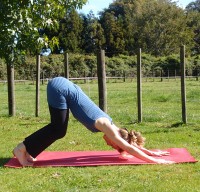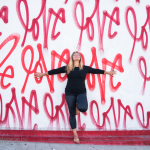Part 1 of this series in the Beginner’s Guide to Yoga gave you a heads-up on things to be aware of before rocking along to your first yoga class.
You might have been to a few classes now and so have got your head around the right clothes to wear, how to fuel your body before and after class, how to position yourself on your mat and how to forget about what other people are thinking.
Now it’s time to start investigating the process of posture (asana) a little more deeply. It’s so easy to think that doing a pose right means looking a certain way in the pose. But that’s not true at all.
Doing a pose “right” can happen even when you’re not super bendy.
Take a look at that photo of me in adho mukha svanasana (downward dog). Not really Yoga Journal-pretty is it? Those bent knees, crooked feet, lifted heels and funny-angled arms… It’s soooo not right, right?
But you know what? I am in the right alignment – for me.
- Because my hamstrings are tight, I can’t straighten my legs without compromising the alignment of my spine or pelvis.
- A naturally long torso is also long, made even longer by the bent legs, creates the long, low angle of my arms.
- Plus I’m still working on even pressure through all four corners of my feet, it’s not coming naturally yet – which creates those slightly crooked feet you see.
- Tight calf muscles mean my heels have plenty of fresh air underneath them too.
The asana is not all bad though – being aware of my limitations and working with them means my spine is straight, my pelvis is aligned, plus my breath is flowing freely. And that’s where adho mukha svanasana really starts. In fact, that’s where most asana start actually.
With the breath, and by extension, with prana… more on that in a minute.
A straight spine and aligned pelvis means that my breath has a clear line to move along and this is really important because it creates a free flow of energy up the spine, which is a big thing in yoga. It doesn’t matter if you’re in garudasana (eagle), navasana (boat), ardha chandrasana (half moon) or gomukhasana (cow), finding your breath in your spine is what helps to open into the posture.
Even in asana where the spine is bending, it’s still important to find your breath so that the spine remains open, even while bending.
Imagine your spine is a garden hose. Bend that hose into a C-shape that keeps the air flowing through the hose. That’s an open spine. Now bend the garden hose so it cuts off the flow of air through it. That’s a closed spine.
In your first few classes, it really helps if you’re aware that doing the pose “right” isn’t about looking like the teacher, or like Yoga Journal. It’s about finding the openness of breath within the current limitations of your body. A good teacher will be able to guide you into asana variations that allow you to support your body wherever it is. Things like bent legs, or sitting on a block in seated asana, or sometimes even using a wall to support yourself in asana like garudasana or ardha chandrasana.
Now back to prana. See, this awareness of the flow of breath isn’t just about oxygen though. It’s about the flow of prana around the body… something your teacher may or may not mention, but it’s happening none-the-less, and being aware of prana is something yoga is all about.
In fact, Shakti is the essence of Hatha Yoga – Shakti being an expression of prana within our bodies, like a river is an expression of water moving through the land. And Hatha Yoga being the yoga of physical postures, as opposed to say Karma yoga which is the yoga of our actions within the world. Yep – yoga is a big, wide world, and there’s much to learn. But let’s keep it simple right now and come back to prana.
So what is this Prana thing?
Prana is the Sanskrit word for life force, and it permeates everything in the entire universe. Shiva Rea says:
Prana derives from the Sankrit word “pra” meaning “to fill”, added to the root word “an” which means “to breathe” or “to live”. It refers to the underlying source of prana as the substance of life most tangibly experienced through the one breath moving us all.
I like that – the one breath moving us all.
In the human body, prana is kinda like an electrical force and it travels around on channels called nadis. There’s like 72,000 of them, some big and thick like a state highway, some small and skinny like a country road.
Prana and breath are often seen as one and the same thing because enters the body via the breath – but they’re not exactly the same. It does mean though that all that focus yoga has on breathing means you’re getting more prana into your body. Plus the practice of asana purifies and strengthens the body so you’re able to handle a stronger flow of prana. Just like 20,000 volts through a light bulb would blow the bulb, so too do our bodies have to be conditioned to receive higher and higher flows of prana.
When the body is all tight and weak, it’s like those nadis have landslides blocking them, or they’re all cracked and weak. Prana can’t travel freely, so you’re not getting energy to all your body’s cells.
As you get stronger and more open, the nadis open up and more and more prana can flow freely along them. Your entire body becomes energised – which is one reason why yoga makes you feel so good.
So when you practice asana, it is about finding the alignment of the muscles, bones and organs which creates shapes that look a certain way.
Yet another way to think about it is rearranging your physical body around energetic lines so prana can flow freely.
It’s the inside-out method of asana, as opposed to the outside-in method. Both of which end up in the same place.
Doing yoga from the inside out is what made my downward dog look like that. I was arranging my body around freely flowing prana. It doesn’t look the way we think downward dog “should” look, but prana is able to flow along through my spine, and with time, my legs will gradually open up, and one day even my feet will be flat on the ground.
So doing asana “right” isn’t so much about being perfect in the pose, but being perfect with where you are at in the pose – bent legs and all, so that prana can flow freely – starting with the spine usually and then moving out into the limbs.
At first when you practice, you may not be able to tune into the subtle sensation of prana in the body – but you can tune into the feeling of breath in your body. Make you focus finding your breath first in the nostril’s, then in the lungs, and finally out into the spine, limbs and extremities and eventually you’ll begin to discern prana flowing around your body.
Or maybe it’s your body that begins to flow around prana.
Enjoy!


Thank you for such an interesting and informative blog. This is the most interesting set of information I have read about Yoga and am very keen to read some more here…
Thank you
LG
I remember reading this a few months ago, and it made such a difference to the way I felt about my postures…you are so right- it is my body, working the way it does- not how someone else’s does! Duh, really obvious, but I was really good at comparing and falling short. Now I wiggle and micro-move as much as I need! Thankyou.You have helped me be.
Hey Gisele,
Thanks for coming back and offering some feedback – it’s great to hear how things have worked for people.
I love what you’re saying here. I always teach new Intro students down dog with bent knees at first, though suggest to straighten them if they can still find comfort and the length in their spine. Most don’t heed the call to patience and awareness of what their body may/may not be ready for, but I still like to offer the option. In DD and in most postures, finding the comfort and the breath is what it’s all about for me.
Hey Jody,
I guess it hard’s to let go of the idea of what the posture is “supposed” to look like… both as a beginner and after practicing for years. I know I still have to remind myself daily to honour my body as it is, while finding an edge to play with…